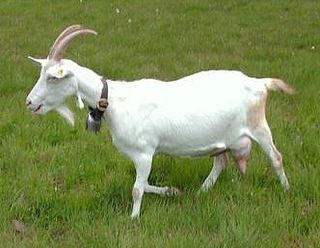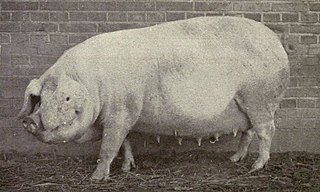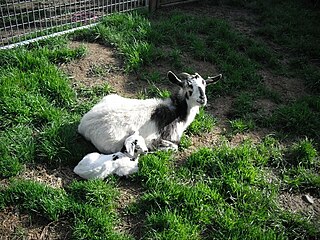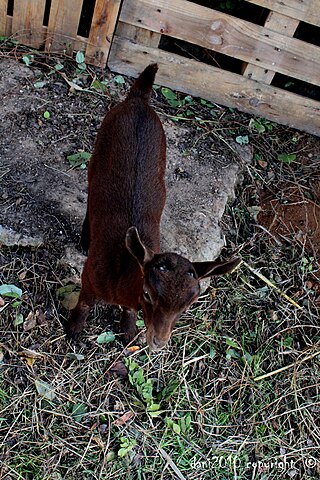
A landrace is a domesticated, locally adapted, often traditional variety of a species of animal or plant that has developed over time, through adaptation to its natural and cultural environment of agriculture and pastoralism, and due to isolation from other populations of the species. Landraces are distinct from cultivars and from standard breeds.

The Saanen is a Swiss breed of domestic goat. It takes its name from the Saanental in the Bernese Oberland, in the southern part of the Canton of Bern, in western Switzerland. It is a highly productive dairy goat and is distributed in more than eighty countries worldwide.

The Toggenburg is a Swiss breed of dairy goat. Its name derives from that of the Toggenburg region of the Canton of St. Gallen, where it is thought to have originated. It is among the most productive breeds of dairy goat and is distributed world-wide, in about fifty countries in all five inhabited continents.

The Danish Landrace, Danish: Hvid Dansk Landrace, is a Danish breed of pig. It is of medium to large size, white in colour with a long body, fine hair, a long snout, and heavy drooping ears. There are two distinct varieties, the white and the piebald.

The American Landrace is an American breed of domestic pig. It is white in color, with a long body, fine hair, a long snout and heavy, drooping ears. Like all landrace pigs, it derives from the Danish Landrace.

The Danish Warmblood or Dansk Varmblod is a Danish breed of modern sport horse, established in the mid-twentieth century and used mainly for dressage and show-jumping. Like other European warmblood breeds, it is a performance breed: any suitable horse of any origin may be admitted if it passes a strict performance test. Hanoverian, Holsteiner, Swedish Warmblood and Trakehner are among those that have contributed to the breed.

The Kiko is a breed of meat goat originating from New Zealand. Kiko comes from the Māori word for meat. The Kiko breed was developed in the 1980s by Garrick and Anne Batten, who cross-bred local feral goats with imported dairy goat bucks of the Anglo-Nubian, Saanen, and Toggenburg breeds. The only aims of the breeding programme were fast rate of growth and ability to survive in the pastoral conditions of the New Zealand hill country.

The Danish Jersey is a modern Danish breed of dairy cattle. It derives from approximately 5200 head of Jersey cattle imported to Denmark from the island of Jersey between about 1896 and 1909. It is the most numerous population of Jersey cattle in Europe and constitutes approximately 13% of the Danish dairy herd.

The British Saddleback is a modern British breed of domestic pig. It was created in 1967 by merging the surviving populations of two traditional saddleback breeds, the Essex and Wessex Saddleback. It is an endangered breed, listed on the watchlist of the Rare Breeds Survival Trust as at risk, the second-highest level of concern.

The Dutch Landrace is a traditional Dutch breed of domestic goat. It has been known in the Netherlands since the seventeenth century, and was formerly numerous there. It came close to extinction in the 1950s, but was saved by cross-breeding with unrelated goats, and by 2020 numbered over 2000 head.

The Irish Goat is a traditional Irish breed of domestic goat. It is a dual-purpose breed, used both for meat and for milk. It is an endangered breed and may survive only in feral populations. It is distinct from the feral Bilberry Goat of Waterford.

The Murciano-Granadina is a Spanish breed of dairy goat. It was created in 1975 when two existing breeds, the mahogany-coloured Murciana of Murcia and the black Granadina of Granada, began to be hybridised as a result of the official recognition of a single herdbook including both breeds. It is the most important dairy goat breed of Spain, with more than 500,000 milking females. It originated in the semi arid areas in south eastern Spain, including parts of Murcia, Almería, Granada and Alicante. They were bred for two main traits, milk production and its ability to continue this production in dry and nutrient poor regions. They have been introduced into several areas in Latin America as well as northern Africa.
The Zhiwulin Black goat breed from the northern Shaanxi Province of China is used for the production of cashmere fiber and meat.
The Xinjiang goat breed from the mountains of Xinjiang in China is used for the production of milk, cashmere, and meat.

The British Lop is a traditional British breed of pig from the West Country of south-western England. It is a large, white-skinned pig with lop ears hanging forward over the face. It was formerly known as the Cornish White or Devon Lop and then, in the early twentieth century, as the Long White Lop-eared or White Lop; the modern name was adopted in the 1960s.

The Italian Landrace is an Italian breed of domestic pig. It derives from the Danish Landrace breed developed in Denmark at the end of the nineteenth century. Stock was imported into Italy after the Second World War. The breed has been selected principally for suitability for the production of prosciutto crudo. It is, after the Large White Italiana, the second-most numerous pig breed in Italy. The breed standard is issued by the Ministero delle Politiche Agricole Alimentari e Forestali, the Italian ministry of agriculture and forestry; the herdbook is kept by the Associazione Nazionale Allevatori Suini, the national pig-breeders' association.

The Marwari is an Indian breed of domestic sheep. It originates in, and is named for, the Marwar region of south-western Rajasthan, in the north-west of India. It is reared in the five principal districts of Marwar – Barmer, Jalore, Jodhpur, Nagaur and Pali – and also in some neighbouring districts of Rajasthan and Gujarat.

Danish landrace goose, or Danish goose, is a landrace variety of goose native to Denmark.

The Pygmy is a British breed of dwarf goat. It is small, compact and generally stockily built. It was established in the 1980s by fusion of the various miniature goat populations of the United Kingdom into a single breed. These were of two principal types: a stocky achondroplastic type derived from the West African Dwarf group of breeds of West Africa; and a small but well-proportioned type derived from the Southern Sudan goat.

















